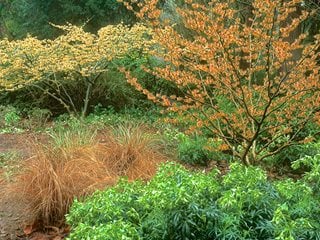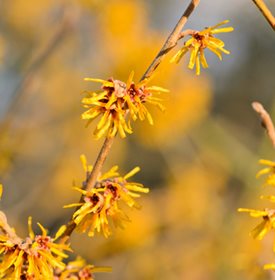Growing & Caring for Witch Hazel

Hamamelis mollis (left), H. ×intermedia 'Orange Beauty' (right). Photo by: Janet Loughrey.
A large deciduous shrub with colorful, fragrant flowers during the winter, witch hazel is virtually maintenance-free and resistant to most pests and diseases. Witch hazels perform best in full sun (or filtered shade in hotter regions), where the flowers glow like fiery embers in the backlight of the low winter sun. They prefer well-amended soil and regular water and are tolerant of acid or alkaline conditions. Native forms are hardier, while most hybrid cultivars grow in USDA Zones 5-8. A more heat tolerant variety, Hamamelis x intermedia 'Diane', can be grown in Zones 5-9. Once established, they are virtually maintenance-free and resistant to most pests and diseases. Witch hazel extract is commonly used for cosmetic and medicinal purposes.
WITCH HAZEL CARE
While most varieties reach 10-20 feet high and wide at maturity, witch hazels can be kept smaller with pruning once they are finished blooming. Prune before summer so that the following year’s buds can develop. Suckering twigs that form around the base should be removed. Once new flower buds appear, branches can be cut and forced to bloom inside.
TYPES OF WITCH HAZEL
There are four main types:
AMERICAN WITCH HAZEL |
Zones: 4-8 Mature size: Up to 20’ tall and wide Bloom time: October to December |
These east coast native shrubs or small trees are commonly found in wooded areas from Canada to Georgia. Clusters of citrus-scented petals appear in late fall before the leaves have dropped. Known for its medicinal properties, the bark extract is used as a time-honored remedy for a variety of skin and other bodily ailments. |
OZARK WITCH HAZEL
|
Zones: 4-8 Mature size: Up to 10’ tall and 15’ wide Bloom time: January to April |
Native to Missouri and Arkansas, this is the most shrub-like species. Its yellow or red flowers are small, but profuse and appear between January and April. |
JAPANESE WITCH HAZEL
|
Zones: 5-8 Mature size: Up to 15’ tall and wide Bloom time: January to March |
The Japanese varieties have showy yellow or red flowers. |
CHINESE WITCH HAZEL
|
Zones: 5-8 Mature size: Up to 15’ tall and wide Bloom time: January to March |
The most fragrant of all species, Chinese varieties begins blooming as early as January and has buttery yellow petals and clear yellow fall foliage. |
Hybrids of Japanese witch hazel (H. japonica) and Chinese witch hazel (H. mollis), which bloom from mid-late winter, were bred for enhanced qualities of flowers (larger and better color), intense fragrance and brilliant fall foliage.
VARIETIES OF WITCH HAZEL
SUCCESS TIPS FOR GROWING WITCH HAZEL
- Witch hazels require a winter chill to attain full flowering.
- They also need summer water.
- Mulching is beneficial for retaining moisture.
DESIGNING WITH WITCH HAZEL
- Companion plants such as hellebores, winter heath, and bulbs of hardy cyclamen and snowdrop can be naturalized around the base. To extend seasonal interest into summer, smaller forms of clematis such as C. viticella are attractive when trained through the branches.
- The spidery flowers and heady fragrance are best appreciated when sited near a doorway or well-used pathway.
- Scott Canning, director of horticulture at Wave Hill, recommends siting them for maximum wintertime drama: put them in a spot where they'll be backlit in the afternoon and the warm sun will encourage their flowers and scent to unfurl.
FAQS
Will witch hazel grow in shade?
As natural understory plants, many will do fine in part shade. However, more sun leads to a longer and better bloom. Heavy shade causes leggy growth and lackluster flowers. The ideal growing situation is morning sun, with light shade during the hot afternoon.
Can witch hazel be grown in pots?
In yards with limited space, witch hazels will thrive in containers for many years, though they will eventually need to be planted in the ground. Containers should be kept moist and the roots protected during extreme cold spells.
Is witch hazel deer resistant?
Although not deer resistant, most sources label them as seldom severely damaged. In other words, they aren’t a deer’s favorite food, but they will eat them on occasion. When witch hazels are young, you can protect them with chicken wire and possibly even a deer repellent.
Why is my witch hazel not flowering?
Witch hazels are usually fairly dependable bloomers. However, the weather can change their bloom time, leaving you confused. In addition, those that are too young might not flower, as well as those in deep shade, or those stressed by bugs or disease.
WITCH HAZEL: THE EXTRACT
The American Indians first discovered that witch hazel bark, boiled into a tea or mixed with animal fats into a poultice, has therapeutic qualities. A natural astringent, it soothes irritated skin and shrinks inflamed tissues, and is a key component of everything from facial cleansers to pore-tightening products, aftershave lotions, and hemorrhoid pads.

Witch hazel extract has been used for cosmetic and medicinal purposes for many years.
In fact, witch hazel extract is said to be the most widely used botanical in the world, outstripping even the ubiquitous aloe. Nonetheless, even the world's largest manufacturer and distributor of witch hazel extracts, American Distilling in East Hampton, Connecticut, relies on wild witch hazel as its raw ingredient for those products. It is harvested sustainably, largely on state lands, by cutters whose families have been involved with the business for generations. Bare twigs and branches are lopped in the cold months, chipped, and then steam-distilled at the factory, where the extract is typically preserved with alcohol. American Distilling is now experimenting with witch hazel perfumes made from the fragrant flowers. But so far, the consensus among those who've tried them is that the invigorating scent may be just too powerful to dab on a wrist or the nape of a neck.
RELATED:
25 Low-Maintenance Shrubs
16 Winter Flowers for Your Garden
Hellebores Offer Late-Winter Blooms
Growing Camellias
Growing Loropetalum













